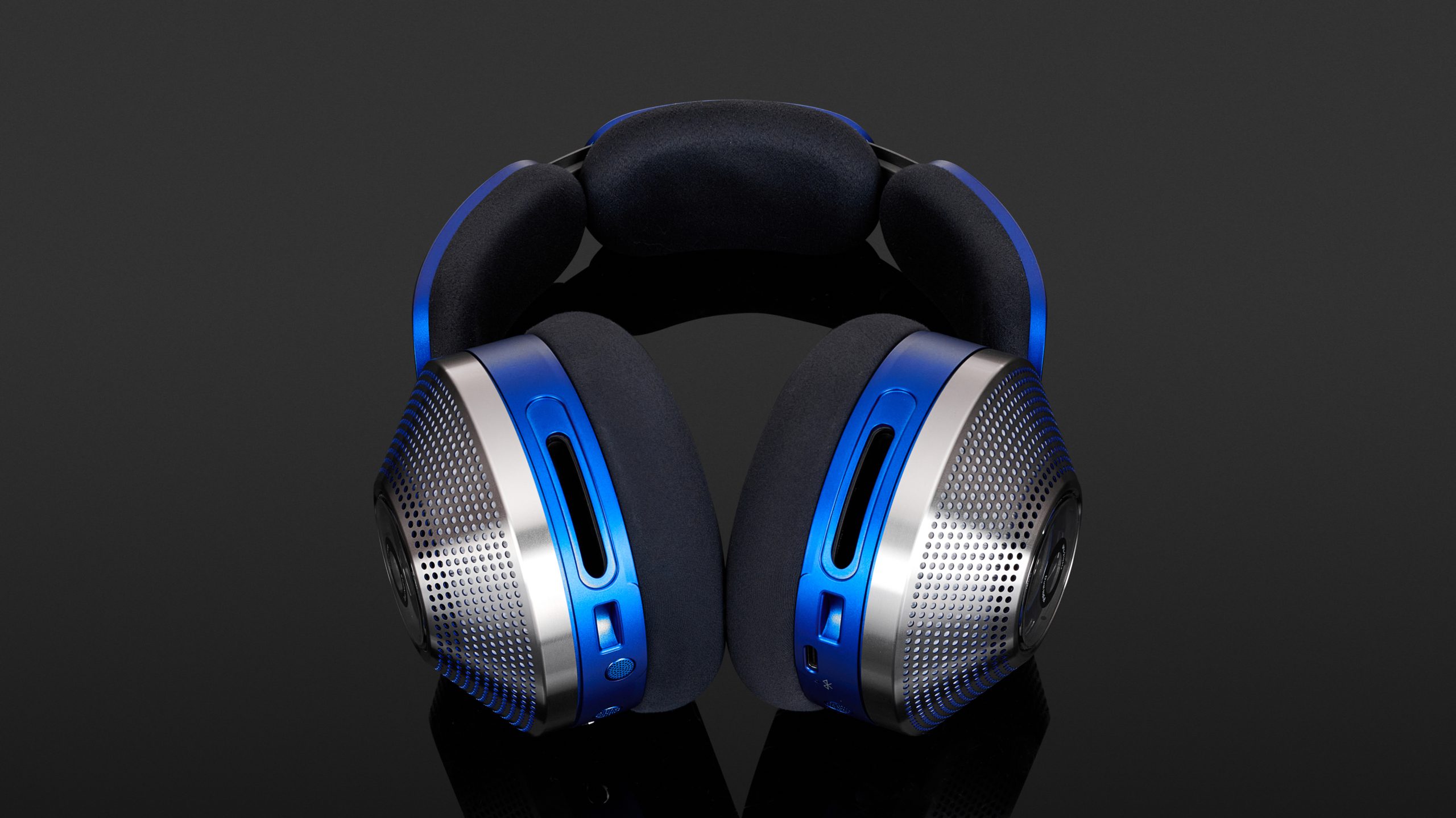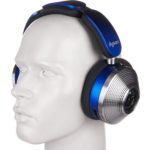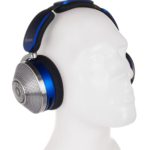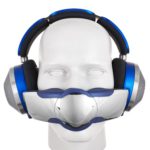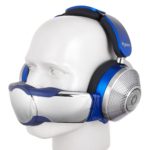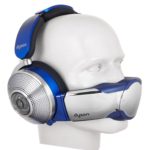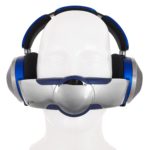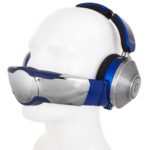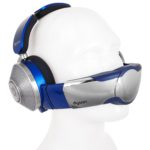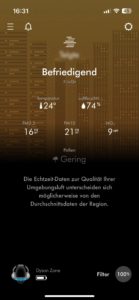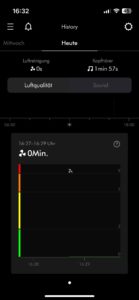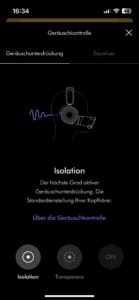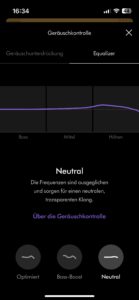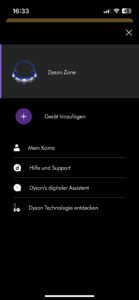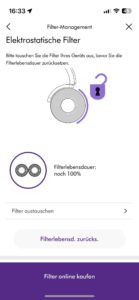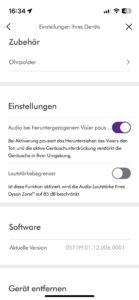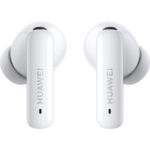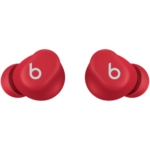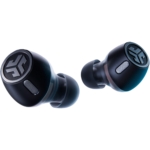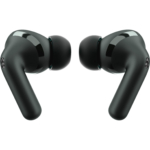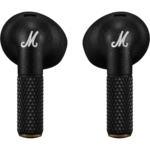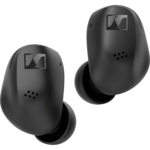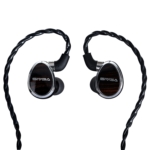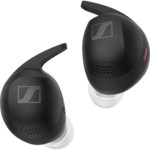The Dyson Zone are anything but ordinary headphones; what makes them special is the combination of air and noise filtering. Sound-wise, they are rather sober, but the noise cancelling is effective, and the transparency mode and app integration are also successful. Unfortunately, the Dyson Zone (still) lacks details.
- Quality of the headphones
- Sound
- Noise cancelling
- Battery life (up to 50 hours)
- Weight
- Touch surface does not always respond
- Equalizer limited with only 3 presets
The brand new Dyson Zone are really eye-catching: they have a futuristic design, large ear cups with a perforated grille and fold-down visor. There’s something very reminiscent of Star Trek and Blade Runner about them! The built-in technology confirms the idea that, with the Dyson Zone, you are wearing a piece of the future on your head.

We were among the first people in Germany to try out the new Dyson Zone as part of a technology event. The device has since reached us for a test, and we were curious to see how well the new “wunderkind” on the headphone scene performed.
UPDATE 9/28/2023: As the manufacturer states, the prices of the Dyson Zone have changed significantly. We have already adjusted the prices in the following paragraph. In consideration of the price reduction of over 250 Euros, our rating for “Price/Quality” changes accordingly. Thus, the Dyson Zone now gets 4.5 stars instead of 3.5.
The manufacturer offers the Dyson Zone in two versions. The cheaper version, in blue and silver, costs 649 euros; the blue/copper colour version has an RRP of 699 euros and offers more extensive accessories (travel bag, aeroplane adapter, etc.). We received the cheaper version for our test.
The idea behind the Dyson Zone
Audio and air pollution – these are two increasingly serious problems – especially in big cities. According to studies by the United Nations, two-thirds of the world’s population will live in cities by 2050. And this means all the associated disadvantages: More traffic not only makes for more noise but, above all, more air pollution, as 70 per cent of global carbon emissions are already emitted in cities.
So, it is understandable and quite logical for a manufacturer to take on these problems. While Dyson has had little experience in the consumer audio world, it has plenty in the field of air purification. Dyson Purifiers, for example, are in-room air purifiers that have become famous, not least for their design.
Design and finish of the Dyson Zone
The Dyson Zone are over-ear headphones that have a high-quality finish, and they fit seamlessly into Dyson’s portfolio because of their design language. You can immediately tell which stable the Zone comes from.
- The Dyson Zone have a high-quality build, but are not particularly light at just under 600 grams.
Large round ear cups with shiny metal elements including a solid suspension, a thick and soft head cushion for pressure reduction and a steel band for size adjustment converge with the built-in technology to make a total weight of approx. 590 grams. That’s quite a lot for consumer headphones. Such “poundage” is otherwise only found in electrostats such as those from Audeze and Co., which offer music enjoyment that is less suitable for use on the move than it is for on the couch at home. And if you also attach the visor so you can use the core function – namely the air filtration – you add another 70 grams. By comparison, the Apple AirPods Max weigh around 200 grams less, while the Sony WH-1000XM5 are twice as light.
The visor, which can be attached using magnets, seems to have a lower-quality finish when compared to the headphones. However, Dyson appears to have made an effort to find the best compromise between weight saving and functionality.
In the package, you will find a drawstring fabric pouch to hold the visor, as well as a hard case that opens and closes smoothly via a large, shiny button. Lined with a velvety material, the case looks very sturdy and protects the expensive headphones and visor perfectly. The dark blue colour used for the case and fabric bag can also be found on the headphones. Finally, there is a fabric-covered USB-C charging cable, a cleaning brush and two air filters that have to be fitted in the ear cups before the first use.
Comfort of wearing the Dyson Zone
I mentioned that the Dyson Zone is not light. However, the weight is well distributed on your head, and the contact pressure is quite high, but if you loosen the headband to relieve the pressure on your skull, you can clearly feel the weight on the ear cups, as the headphones “pull” slightly on your temples and ears. After about an hour, I had to take the Zone off my head and take a short break to relax. The large ear pads (diameter approx. 10 cm), when added to the contact pressure, ensure very good passive shielding.
The visor, held in place by magnets, offers a kind of rubber lip as a seal, which at the top sits over the nose and the jawbones or cheeks at the bottom. This system does not form a closed space. The gap always ensures an exchange of air. The visor can also be placed closer or further away from the face by means of rails, although you have to ask how high the filtering effect then remains. In any case, this essential component does not restrict wearing comfort, nor do the earpieces, which are gently enclosed by the soft ear padding.
- The visor of the Dyson Zone has channels that direct the air to the nose and mouth.
Operating the Dyson Zone
There are a few controls on the Dyson Zone: On the left, a round button controls the intensity of the air filtration, and this has three different levels of intensity from “Off” to “Automatic”. These range from resting, sedentary activities (low airflow) to simple outdoor movements (e.g. going for a walk) through to light sport, which provides the strongest airflow. If this button is pressed for a little longer, the Dyson Zone will switch to Bluetooth pairing.
On the right ear cup, there is a small joystick that controls the volume and playback (play, pause, track forward and back, forward and rewind) as well as summoning voice assistants.
Touch commands are also supported, although it is only possible to switch from noise cancelling (ANC) to transparency mode via a double-tap. In practice, this does not always work reliably: In fifty per cent of cases, the Dyson Zone did not respond to a double tap. The touch-field at the front edge also seems to be more receptive to touches than, as stated by the manufacturer, the middle.
MyDyson app: manage the Dyson Zone
If you want to make further settings, then you will need an app (iOS, Android). Owners of other Dyson products may already be aware of this. Not only can you browse help topics here, but you can also install firmware updates or procure spare parts and add-ons. The electrostatic filters, which have to be inserted before initial operation (see above), lose their filter effect due to their design, so replacements can be ordered directly via the app. Prices for these are not yet available, but in view of the purchase cost of the visor cleaning brush included in the package, which costs a hefty 40 euros, the filters are not likely to be cheap items either.
The core of the app includes real-time monitoring of air and noise pollution as well as switching the airflow, ANC, transparency mode and equaliser.
The real-time data are clearly displayed in diagrams and not only show the pollution levels in the air but also represent volume measurements for the headphones inside and outside the earpiece, including warning messages if limits are exceeded.
Generally, the app looks smart and tidy, even if calling up the sound and filter settings is not self-explanatory at first glance. For example, when you tap on “Isolation”, a window “slides” up, and this displays the ANC circuit on two tabs as well as an equaliser, and with 3 pre-sets, this seemed to me to be very limited. Unfortunately, it was not possible to create your own sound curve. There is potential for an update or a version 2.
Sound of the Dyson Zone
At the Dyson event, we had already been struck by the sound, which was unspectacular in the best sense of the word, and this was no different in our full test of the final product: The Dyson Zone sounded sober, almost cool in neutral and was reminiscent of linear studio headphones such as the AKG K702.
The bass range was clear, defined and clean.Tonalities were detectable down to the lower registers, but there was no question of boosted bass. Thus, the Dyson Zone lacked a warm basic character of the kind you might be used to from other consumer headphones.
The mids were also slightly boosted towards the transition to the treble, which reproduced voices clearly and conveyed transparency. The treble experienced a slight increase according to the neutral curve, only to slowly drop again slightly towards the upper listening limit. Unfortunately, this made for a somewhat tiring sound. This was also the case because it tended to be sharp in songs with a spiky mix and S-sounds at higher volumes (e.g. Neneh Cherry’s “Buffalo Stance” and Madonna’s “Jump”).
For closed headphones, however, the Dyson Zone illuminated the virtual soundstage nicely: Panoramic movements could be followed clearly, and movement into the room was also rendered quite vividly.
Fortunately, there was no sonic difference when switching ANC, transparency and everything off.
Noise cancelling and transparency mode of the Dyson Zone
The Dyson Zone’s noise-cancelling system packed a punch and not only cancelled out low-frequency static noise but also higher frequencies such as keyboard clatter or voices. Although these remained slightly perceptible, they dulled to such an extent that the headphones had to be removed or operated in transparency mode in order to understand a conversation from about three metres away. Comparable performance to the Apple AirPods Max, Bose Headphones 700 or the Sony WH-1000XM5.
Meanwhile, the transparency mode allowed outside noise to reach the ear but also raised the background noise. Still, this sounded similarly natural to, for example, the AirPods Max.
If you want to communicate quickly with a fellow human being, then you can do so quickly by folding down the visor. When you do this, the air purification function switches off, and media content is paused – and the same thing happens when the headphones are taken off – and the transparency mode is activated.
However, you have to take into account the filter fans in the ear cups. These were constantly noticeable with hissing and whirring, regardless of whether they were set to level 1 or 3; the latter was so loud that others “got wind” of it. If you don’t want this to happen, you have to deactivate the air filter function completely. We should also point out that this had a serious impact on battery life: in our practical test with medium air filtering and high volume, the Dyson Zone didn’t manage to last four hours, while we managed just under 50 hours with only ANC activated.
Filtering air
That Dyson has a lot of experience with purifying air is evident from its broad portfolio of air purifiers. Combining this experience with a pair of headphones is understandable, and it was certainly only a matter of time before they came up with it. But we headphone fans, who have had no contact with this functionality so far, unfortunately, cannot adequately judge how well the Dyson Zone is able to filter pollutants. The manufacturer states that the Dyson Zone can filter pollutants down to a size of 0.1 micrometres. However, due to the gap between the visor and the face, polluted air can still reach the mouth and nose. Therefore, the headphones do not offer complete protection.
Making calls with the Dyson Zone
Of course, you can also make phone calls with the Dyson Zone. The speech intelligibility was very good. Our conversation partner sounded natural and direct, and we were always intelligible. If the air filter function was switched on, the person we were speaking to noticed a “crackly” noise, especially when it was at the strongest setting.
Conclusion
The Dyson Zone are unusual headphones. They combine air and noise filtering at an extremely high level and sound so sober that you could almost think you were dealing with linear-sounding studio headphones! The noise cancelling worked very well, and the transparency mode and app integration were also successful. Unfortunately, the touch surfaces on the device we tested were still a problem and – this may be the biggest problem for most of us – the high price and the look might be off-putting. The look is so unusual that Dyson will have a hard time establishing itself on the streets. And pollution levels in big European cities are not on the scale of Asian mega-metropolises. But who knows; Apple’s distinctive design was ridiculed at the beginning and ultimately became the content of numerous memes. That doesn’t have to be a bad thing.
Technical specifications
- Ear couplingOver-ear
- Typeclosed
- Transducer principledynamic
- Frequency response (headphones)6 - 21.000 Hz
- Weight with cable710 g
- Weight without cable669 g
- Cable length150 cm
What's in the box
- Visor
- Visor cleaning brush
- Fabric bag
- USB-C charging cable
- Hardcase
Special features
- in zwei Versionen erhältlich
- BT codecs: SBC, AAC, LHDC

















